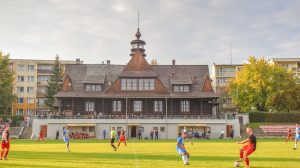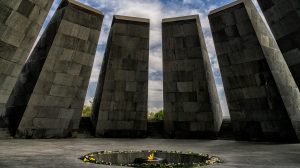Countless cities in Europe claim to be Where East Meets West, but all must bow-down to Sarajevo in that particular category. History here stretches back to the Neolithic period, all the way through the empires of the world through to its current incarnation as the capital city of an independent Bosnia and Herzegovina. The so-called Jerusalem of Europe is home to all the continent’s religions, and it continues to straddle the divide between the two worlds today.
Why visit now?
Does one really need an excuse to visit Sarajevo? Few cities offer as much as the Bosnian capital. Food lovers will be in dreamland, while history buffs will find themselves overwhelmed with the sheer amount of stories from Sarajevo, from way back when all the way to the current day. Sarajevo may not be the undiscovered gem that some wish it was, but it remains a gem that all should discover for themselves.
Get your bearings
Sarajevo is surrounded by mountains, so much so that the technique required to fly into the city has a place in pilot textbooks worldwide (the so-called Sarajevo Approach). The airport is located six kilometres from the train and central bus station (themselves located three kilometres from the city centre). Avoid taxis outside the stations — public transport is simple and easy to use. Buy your tickets from a kiosk, and don’t forget to validate your ticket once on board. Buses from Serbia arrive and depart from Istočno Sarajevo bus station in Lukavica, a 40-minute bus ride from downtown.
Sleep
Sarajevo is a major international centre for visitors of all means, so it is no surprise to find a healthy mix of accommodation options for all budgets. The Holiday Inn retains a certain macabre charm thanks to its wartime reputation (although these days it just the Holiday, without the Inn), and there are a number of five-to-three-star hotels throughout town. At the other end, Haris Youth Hostel remains the best of the hostels, located on Vratnik but well worth the uphill slog. Anyone who opens a hostel at the age of 15 (as its owner did, many years ago now) deserves respect.
Baščaršija (the Old Town market, if your tongue is tied)
Where better to start the grand tour of Sarajevo than the heart of the city? Sarajevo’s Baščaršija is the main event and rightly so, a charming collection of narrow alleys lined on both sides by a wide variety of stores that offers as much for the tastebuds as it does the souvenir shelf. Modern day tat shops and incarnations of historic crafts dominate the latter, while the Old Town is home to many of Sarajevo’s best restaurants. The Emperor’s Mosque is the highlight, the first mosque built in the city.
A little bit of history (in fact, a lot)
Take time to stroll along the Miljacka river and soak in Sarajevo’s storied past. The Latin Bridge is its most famous spot, a relatively innocuous bridge that played host to the spark that set the world aflame for half a decade at the beginning of the 20th century. It was here that Gavrilo Princip assassinated Franz Ferdinand way back in 1914, giving the world powers the excuse needed to set World War I in motion. The Museum of Sarajevo sits opposite the bridge. Sarajevo City Hall is nearby, a magnificent structure reconstructed following major damage during the war.

Eternal flame
Sarajevo’s old town gives way to its more modern equivalent, a long pedestrian street called Ferhadija that is lined with shops, cafes and parks full of old chaps playing oversized chess. Ferhadija climaxes with the Eternal Flame, a does-what-it-says-on-the-tin monument to lives lost during World War II. Double back towards the old town via the street named after Mula Mustafa Bašeskija and you’ll pass the Markale market, today a bustling centre of trade that has recovered from the horrific massacres of the war.
Tunnel Museum and Ilidža
Also known as the Tunnel of Hope, this underground walkway was built in the first half of 1993 as the people of Sarajevo desperately tried to release the pressure of the violent siege. Just a small portion of the tunnel remains but its story is told in the museum, one of the city’s most visited sights. The museum is located in Ilidža, Sarajevo’s main suburb and a fascinating historic spot in its own right, once described by the English media as ‘one of the most beautiful places in the world’.
A city of hills
Sarajevo is surrounded by hills, and you don’t need to be an expert to realise that the best views of this beautiful city can be found way up high. The most popular vantage point comes from the White Fortress (Bijela Tabij), a 16th-century fortress that now lies in ruins in the Vratnik neighbourhood. The views are breathtaking, and the addition of a setting sun makes this Sarajevo’s most beautiful spot.
The best restaurants in Bosnia and Herzegovina
Foodies are in their element in Sarajevo, a statement that is doubly true if grilled meats are your thing. The country’s finest restaurants are found in the capital city, a conveyor belt of quality that covers traditional Bosnian cuisine and more contemporary fare. Our favourite is BistroNomie, the work of a talented local young chef, while Klopa is a terrific, fusion eatery which combines the best of Bosnia’s flavours. Almost all of the little restaurants in the Baščaršija are excellent.
Sarajevo in one paragraph
How to sum up somewhere so vibrant and engaging in one paragraph? Sarajevo is many different things to many different people, a treasure-trove of history and culture that serves up the best food in a country famous for toothsome fare. The truth is that there is more to Sarajevo than glowing words — this is a city that demands your attention and won’t struggle to keep it.






[…] Sarajevo city guide: Getting the best out of the Bosnian capital – Emerging Europe Sarajevo city guide: Getting the best out of the Bosnian capital Emerging Europe […]
[…] Imej via [emerging-europe] […]